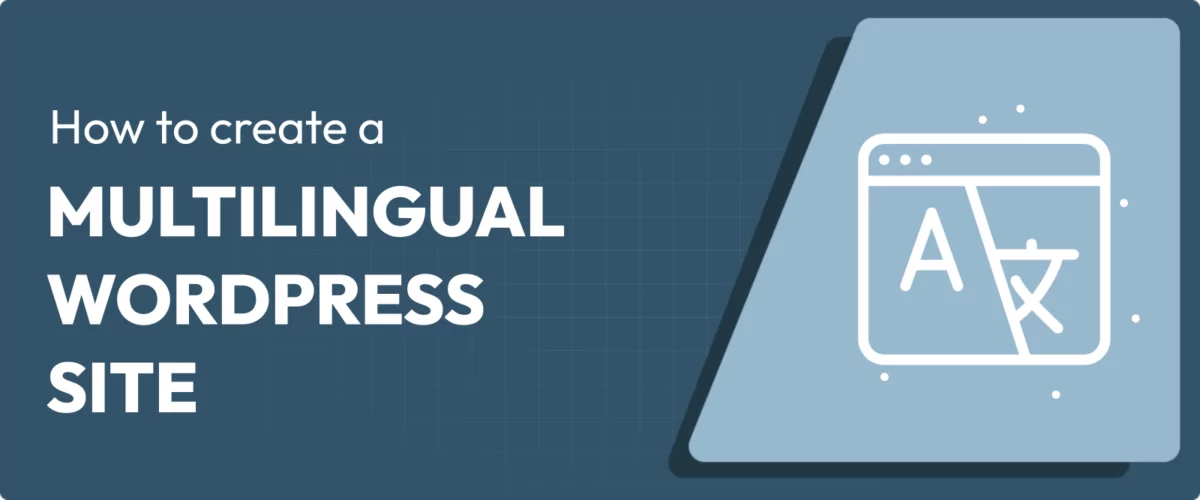
In this post
Creating a multilingual WordPress site is great for your site’s SEO and user experience. You’ll be able to reach new visitors in Google search and let your multilingual audience browse your site in their preferred languages.
That’s all well and good, but creating a multilingual WordPress site can also feel overwhelming. You have all that content to translate. All those random text strings from the themes and plugins that you’re using. How do you make everything work?
With the right WordPress translation plugin, translating your WordPress site into different languages doesn’t have to be a chore. To prove it, we’re going to show you exactly how to start translating your site into new languages.
By the end of this post, you’ll be able to translate 100% of your content by simply clicking on a live version of your site – no special knowledge needed:
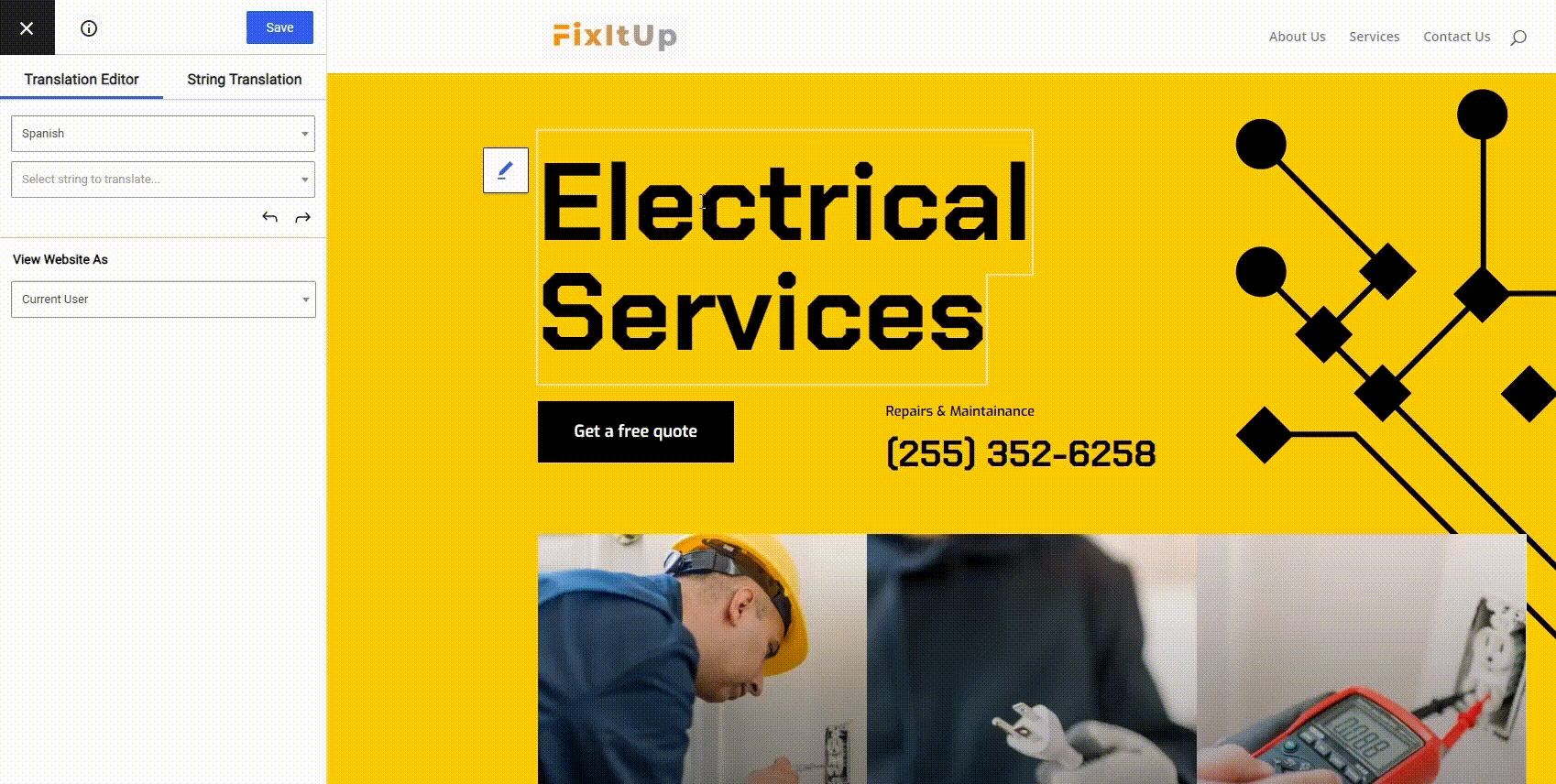
If you don’t want to translate everything from scratch (or pay for a translation service), you can also use an automatic AI translation service to seamlessly translate all of your content using a smart mix of the top automatic translation services.
Let’s get started…
Important Considerations for Translating Your WordPress Site
If you want to get all the benefits of a multilingual WordPress site, you’ll need to look for some specific functionality in your translation plugin of choice.
1. Multilingual SEO
Translating your WordPress site into different languages gives you a chance to start ranking in Google for queries in new languages. The great thing is that you don’t have to create any new content to do this – you can just repurpose ideas you already have into a new language.
However, if you want to optimize your WordPress site’s multilingual SEO, you’ll want to look for a plugin that implements key functionality like:
- Indexable URL structure – typically either a subfolder or subdomain;
- Multilingual sitemap support;
- Hreflang support;
- Translatable SEO metadata.
Implementing these techniques will help your site’s content rank in all languages, which sets you up for success.
2. Front-end Usability
The vast majority of people (9 out of 10 internet users) say that, when given the choice, they always visit a website in their own native language, so translating your site is a great way to give those people what they want and improve your site’s user experience.
However, you can only make that happen if you make it easy for people to find their preferred language.
Look for a tool that helps you add a front-end language switcher at a minimum. Some tools also let you detect user language automatically and redirect visitors to their language based on their IP address or browser settings, which is how many large websites handle things (including Google).
3. Translation Completeness
There are a lot of moving parts to your WordPress site and it can be tough to find a tool that makes it easy to translate all of them.
You have content from the WordPress Gutenberg editor, text from your theme, like your widgets, and content from any plugins that you’re using.
With all that going on, it’s easy for a few text strings to get lost in the shuffle (and not translated), especially when dealing with dynamic content (gettext). Obviously, it’s not good to have untranslated content floating around.
So if you’re serious about creating a multilingual WordPress site, make sure your tool of choice is going to let you translate everything.
The TranslatePress Plugin Ticks All the Boxes
TranslatePress is a WordPress translation plugin that comes in both a free and premium version and hits all the features above.
It lets you translate your site manually, with automatic machine translation powered by TranslatePress AI (or Google Translate and DeepL), or with a combination of both. That is, you can start with automatic translation and then go back and make manual edits.
If you use TranslatePress AI, TranslatePress will automatically use the best translations by combining the might of some of the top machine translation services, such as Google Translate, DeepL, and Microsoft Translator.
The way TranslatePress handles translations ensures that it can translate 100% of your site, including all the content from your theme and plugins.
And it also sets you up with a multilingual SEO-friendly foundation, with indexable versions of your site for each language, multilingual sitemaps, and more.
Best of all, it lets you translate your content with a visual translation interface that looks a lot like the WordPress Customizer, which makes it super easy to manage all your translations.
And once you’ve translated your site, you can display a language switcher as a floating button, a menu item, via a shortcode, or with a widget.
Here’s how it works…
How to Create a Multilingual WordPress Site
Now that you know the theory behind running a multilingual WordPress site, let’s dig into the actual how-to and show you how you can get up and running with TranslatePress using the free version that’s available at WordPress.org.
Setting up the basics will only take you a few minutes and you don’t need any special technical knowledge to follow along.
But before we start, you can watch this short video that briefly explains the process if you’re in a hurry:
Now, let’s get into the full tutorial.
To get started, make sure to install and activate the TranslatePress plugin on your site.
1. Choose the Languages That You Want to Use
Once you’ve activated the plugin, head to Settings → TranslatePress to configure the basics.
Here, you can choose the language that your site currently exists in, as well as which languages you want to translate your content into.
For example, if your site is in English and you want to translate it into Spanish, you’d configure it like this:
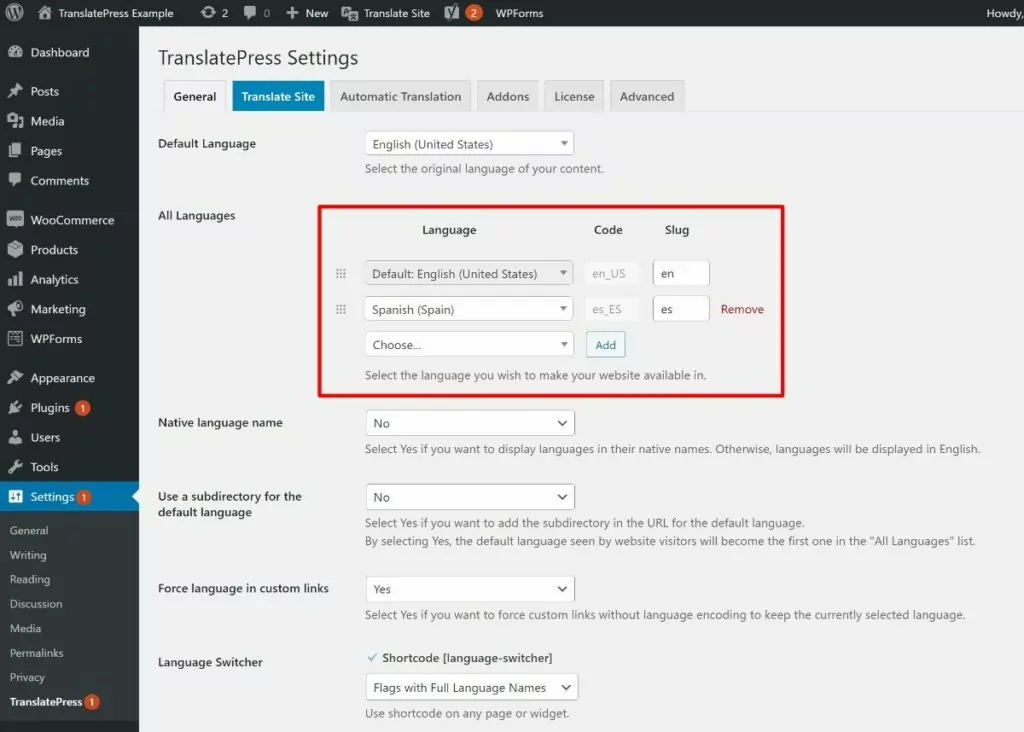
2. Choose How to Translate Your Content
The Automatic Translation tab lets you choose whether or not to automatically translate your site or WooCommerce store.
Automatic translation is totally optional, but it can be a great way to quickly get up and running with a multilingual site.
The simplest option for automatic translation is to use TranslatePress AI, which is TranslatePress’ own smart automatic translation service. TranslatePress AI leverages multiple machine translation services, such as Google Translate, DeepL, and Microsoft Translator.
TranslatePress AI will automatically choose the best translation for each string on your site, which means that you can get up and running with quality translations right away.
There’s also no real configuration process – TranslatePress AI is already linked to your TranslatePress account, so you can use it right away. You’ll get a certain amount of free usage with your TranslatePress license and you can always purchase more if needed.
You also have the option to use either DeepL or Google Translate directly. However, the setup process will be a little more involved because you’ll need to connect your site to your chosen service. For example, if you want to set up Google Translate, you’ll need to generate a Google Translate API key to connect to the service.
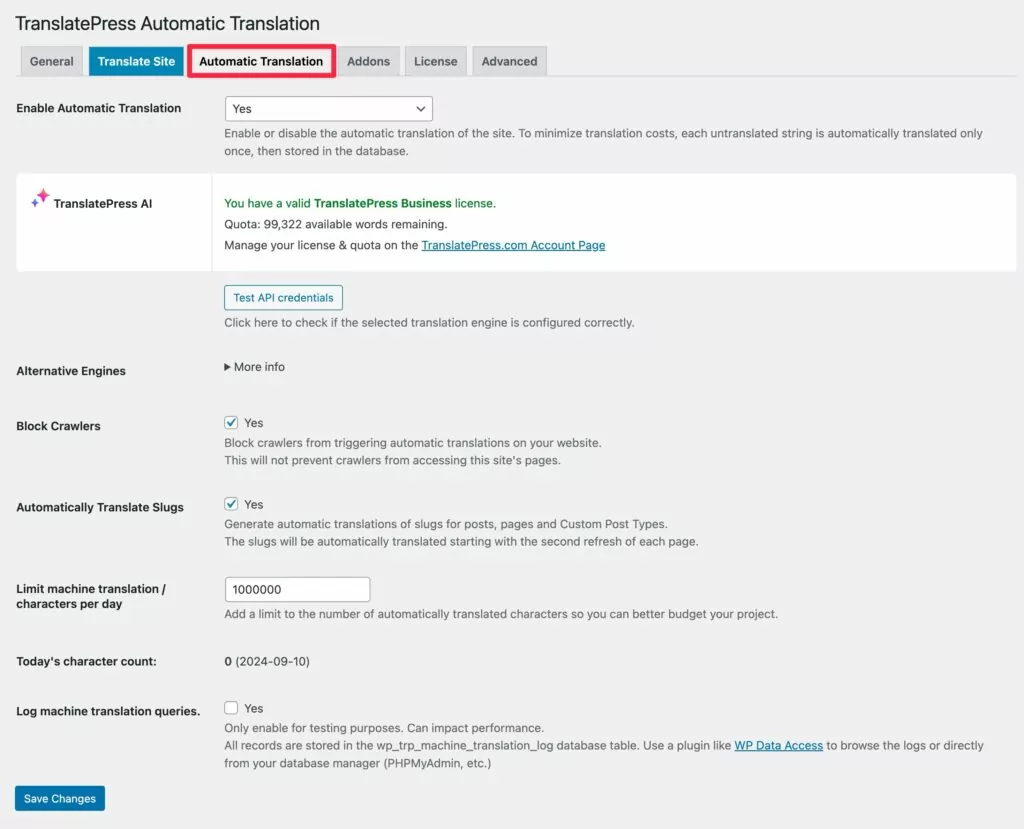
Once choose your preferred approach, TranslatePress will use machine translation to automatically translate your entire site. Then, you can always go back and manually adjust those translations.
3. Configure the Language Switcher for Your Visitors
By default, TranslatePress adds a floating front-end language switcher for your visitors to choose their preferred language(s).
In addition to this floating option, TranslatePress also lets you add a language switcher using the following options:
- Dedicated menu (Appearance -> Menus);
- A shortcode that you can add anywhere on your site (including sidebar or footer widgets);
- A PHP function that you can add directly to your theme template files.
To view and configure these options, you can go to the Language Switcher settings in the main TranslatePress settings area:
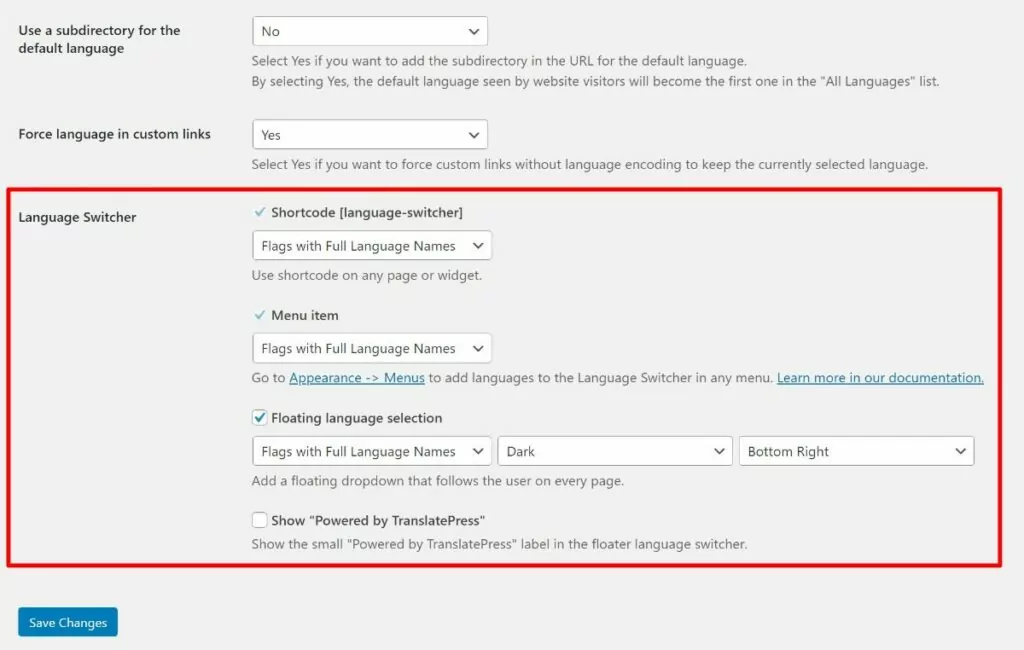
Once you’ve made your changes, click Save Changes.
4. Start Translating Your Content
At this point, you’ve finished the setup and you’re ready to start translating your WordPress site!
The nice thing about TranslatePress is that you can use one visual interface to translate everything on your site.
To access this interface for a page that you want to translate, you can click the Translate Page button in the WordPress admin toolbar:
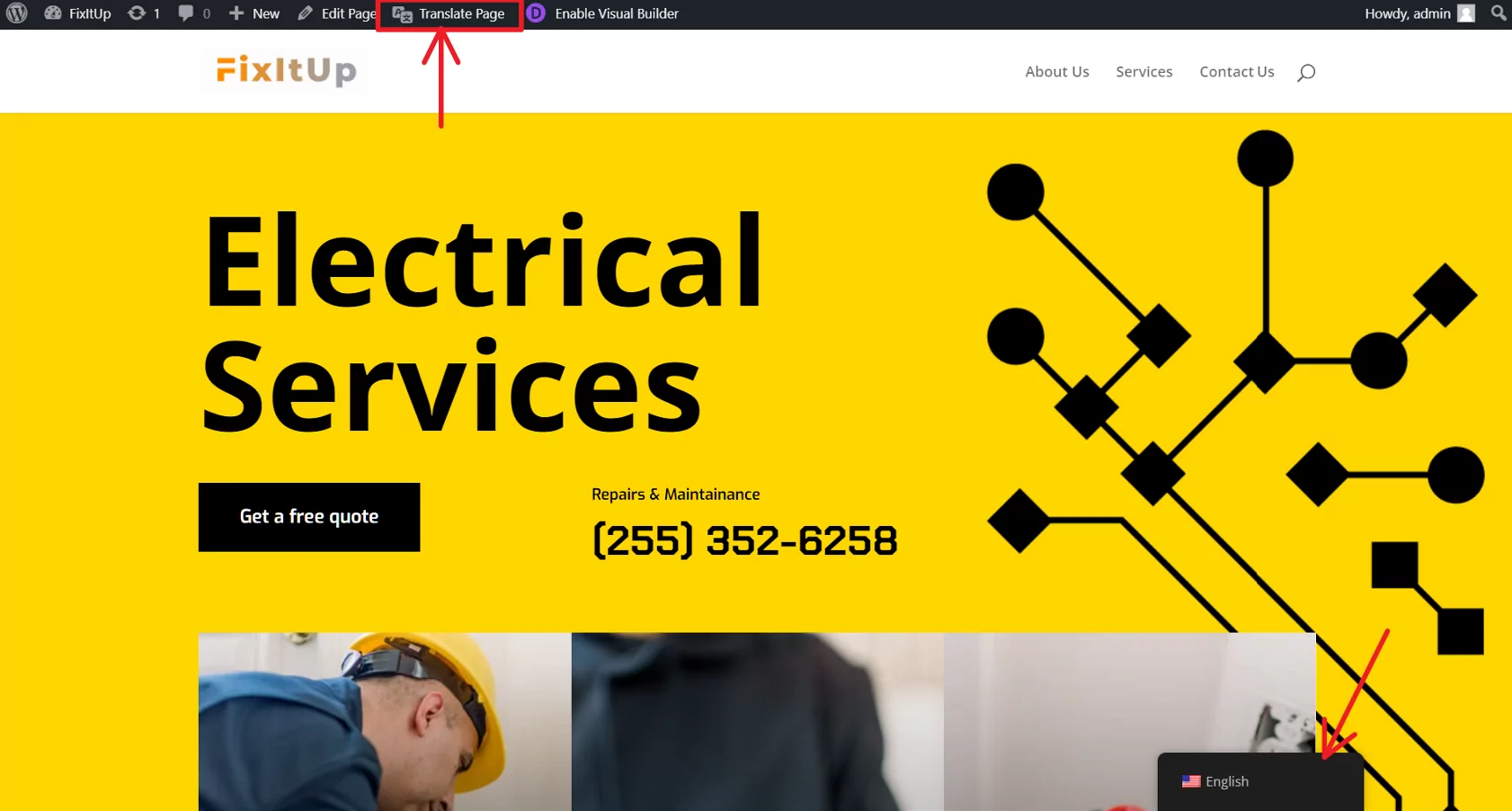
You can also see the floating language switcher that TranslatePress automatically adds.
Once you open up the translation editor, you’ll see an interface that looks a lot like the regular WordPress Customizer.
To edit or add any translation, you can:
- Hover over it on the live preview of your site and click the pencil icon;
- Use the drop-down on the left to search or browse all the content on the page.
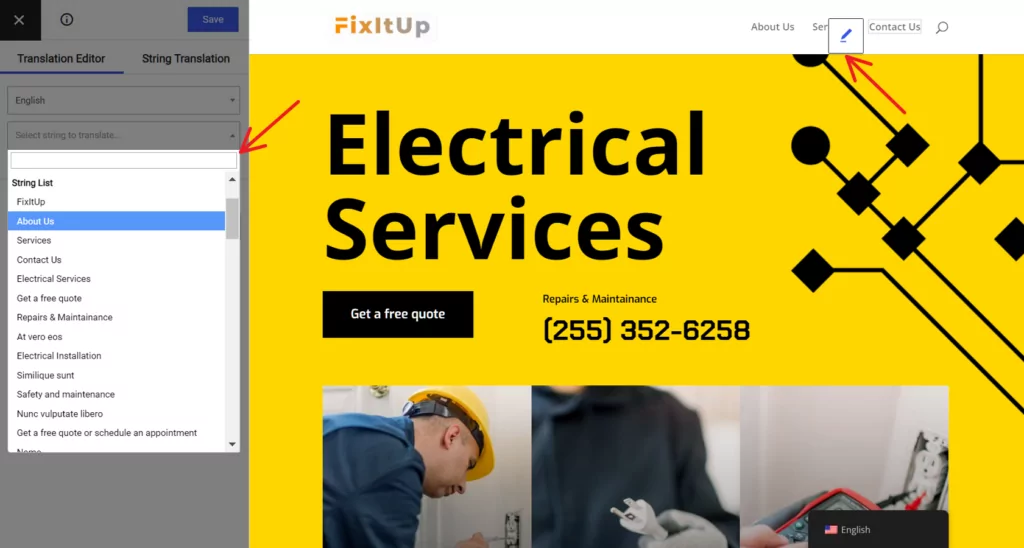
Once you select something to translate, you can make your edits right there in the sidebar:

This interface lets you translate anything. For example, right now we’re translating a landing page built with the Elementor page builder.
But you can also use this interface to translate…
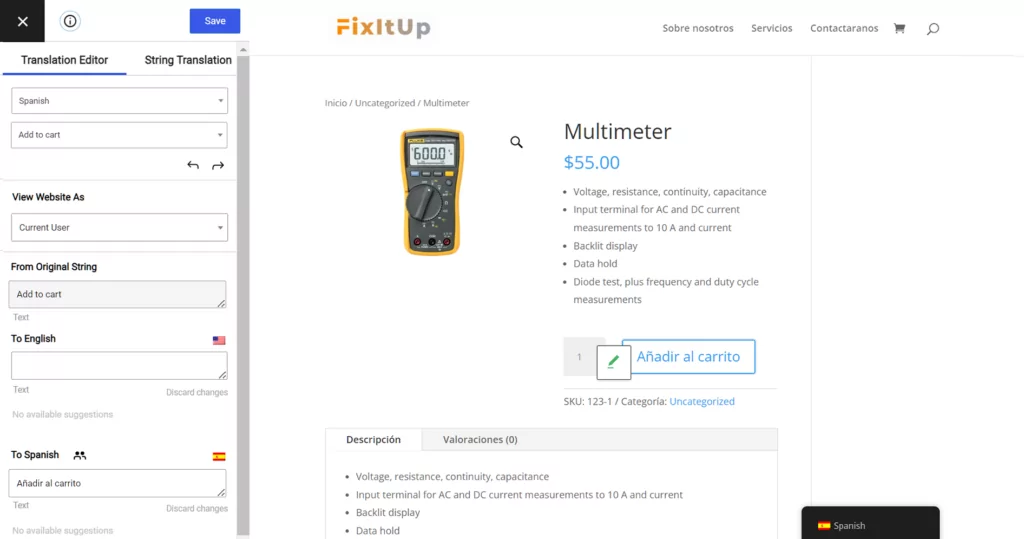
A contact form that you created with your favorite contact form plugin…
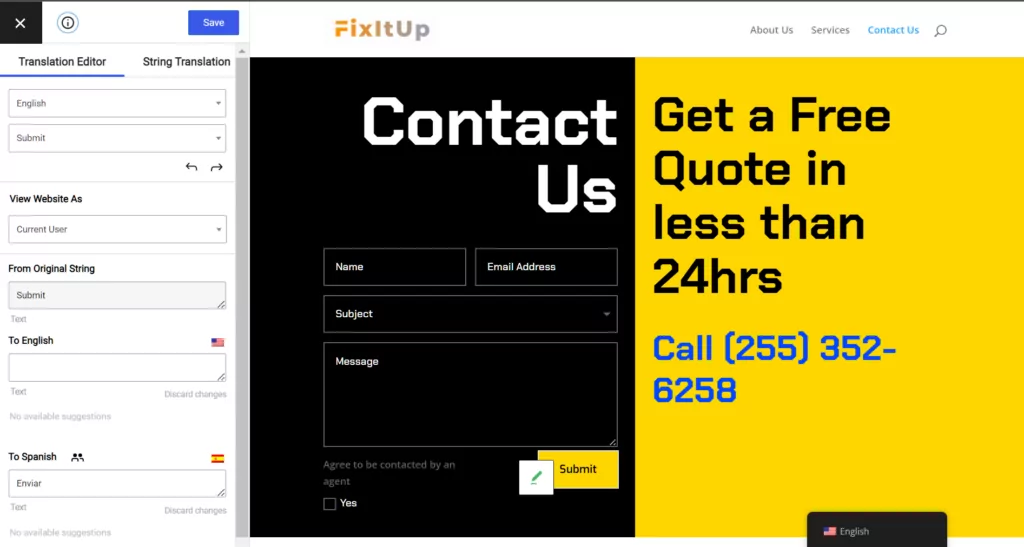
A popup that you created with your favorite popup plugin…
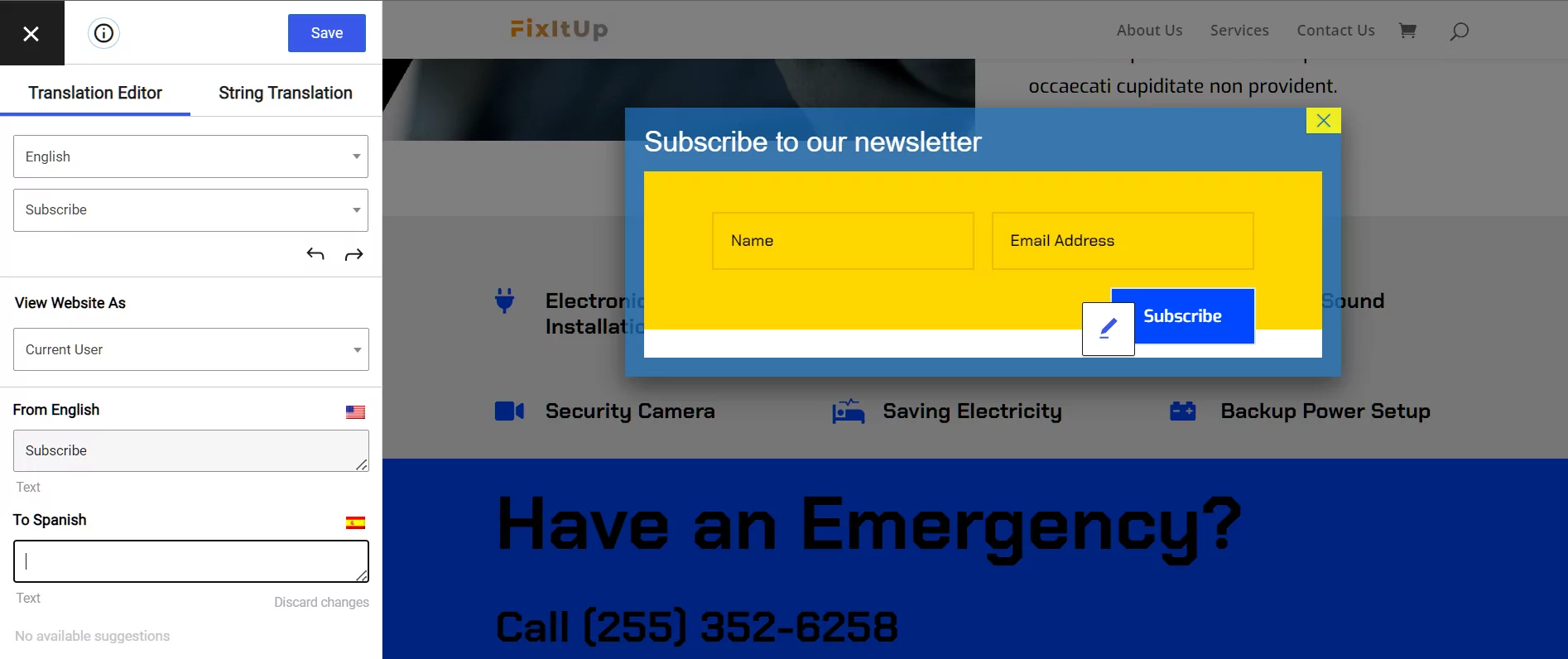
And you can even “translate” images and display different ones based on a user’s language, which lets you translate image content, too:
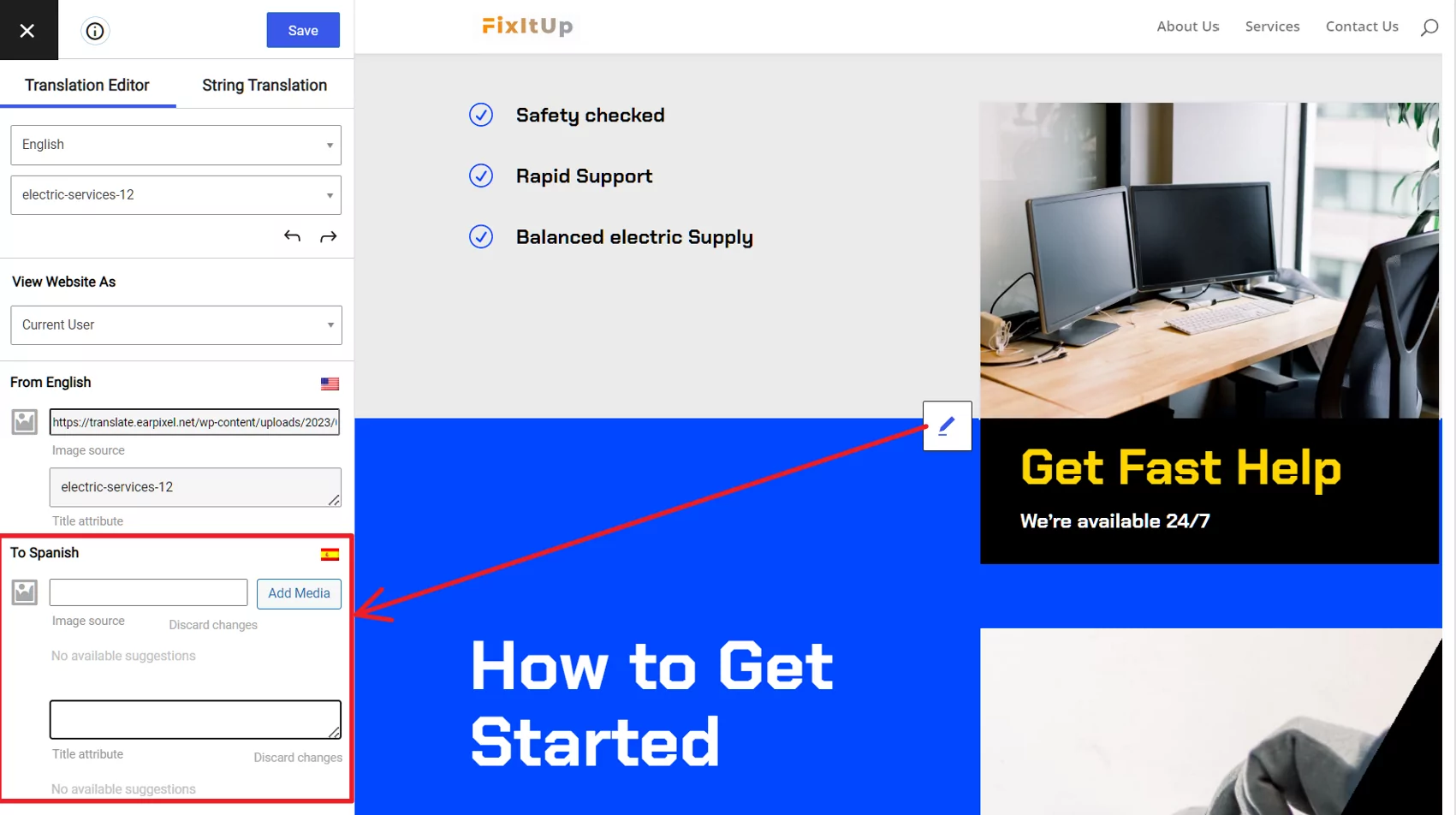
You get the idea – if it shows up on your site, you can use TranslatePress to translate it – it doesn’t matter where it comes from.
You can even browse as different user roles, which is super helpful if you’re running a multilingual membership site or any other situation with registered users.
For example, if you have special content that only logged-in users can see, you can use the View As option to change how you’re browsing:
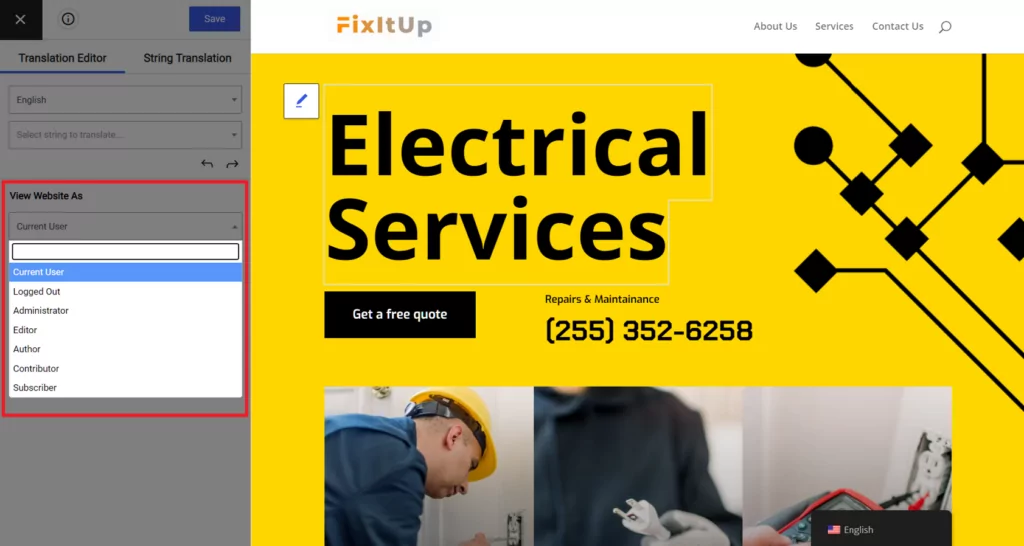
Translate Your SEO Data and URL Slugs, Too!
In addition to translating all the content on your front-end site, TranslatePress can also help you translate important SEO and social media information such as:
- Your SEO title and meta description from a plugin like Yoast SEO or Rank Math;
- Your social media graph descriptions (you can also set these from Yoast SEO/Rank Math);
- All the URL slugs on your site.
To unlock the ability to translate these elements, you’ll need the premium TranslatePress SEO Pack add-on, which is available on the Personal license – purchase it here.
Once you install the SEO Pack addon plugin alongside the core TranslatePress plugin, you’ll be able to manage the translations for these elements using the same interface that you saw above.
Because the SEO elements aren’t visible on the page, you’ll need to use the drop-down in the sidebar to manually select them. Then, you can edit their translations just like any other piece of content.
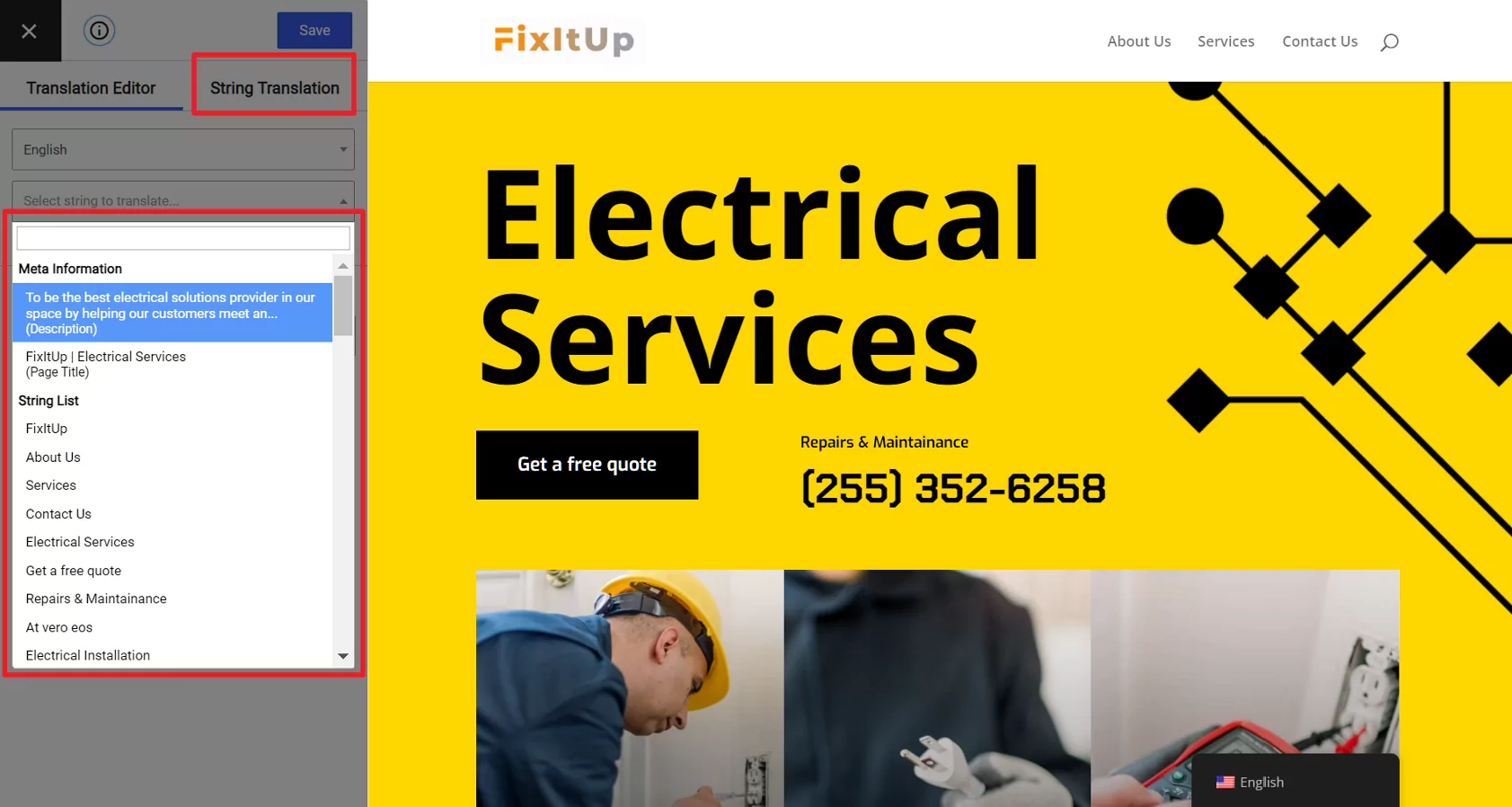
To open the interface to translate all of your site’s URL slugs, you can launch the String Translation editor (highlighted above), which should appear once you’ve activated the SEO Pack addon.
In addition to these new SEO-focused translation capabilities, the SEO Pack add-on also helps you improve your site’s multilingual SEO in other ways, such as creating a multilingual XML sitemap.
5. Explore the Other Premium Features (Optional)
The free version of TranslatePress gives you everything you need to create a totally working multilingual WordPress site without spending a dime.
However, in addition to the SEO Pack addon that we detailed in the previous section, there are some other big benefits to considering the premium version of TranslatePress.
First, the pro licenses let you translate your site into unlimited new languages, while the free version only lets you translate your site into one new language. So if you want to offer more than one new language, you’ll definitely want to upgrade.
The pro licenses also give you a certain amount of free TranslatePress AI usage. This starts at 50,000 words on the Personal plan and goes up to 500,000 words on the Developer plan.
Beyond that, you’ll get other add-ons for:
- Automatic User Language Detection – automatically redirect visitors to their language based on their IP address or browser settings.
- DeepL Support – connect your site directly to DeepL for automatic translation (the free version only supports Google Translate).
- Translator Accounts – let special translator users translate your site’s content without having to use the WordPress backend.
- Browse As User Role – browse your site as different user roles in the editor, in addition to the logged-in/out option in the free version.
- Navigation Based on Language – show different menu items based on language, rather than just translating your existing menu items.
Get Started with a Multilingual WordPress Site Today
With the right WordPress translation plugin, creating a multilingual WordPress site doesn’t have to be intimidating.
TranslatePress offers a non-technical way to translate 100% of your next multilingual WordPress site. Using its visual interface, you’ll be able to search for strings, or just click on the part of your website that you want to translate.
With TranslatePress AI, you can also get up and running in no time, while leveraging translations from the best machine translation services available.
TranslatePress works with regular WordPress content, as well as all themes and plugins, including page builders, popup plugins, form plugins, eCommerce plugins, custom fields plugins, and more. With the premium SEO Pack addon, you can even translate SEO metadata and social media information.
To get started and create your multilingual WordPress site, install the free version from WordPress.org and start translating.
Then, upgrade to the premium version to access the SEO Pack add-on, support for unlimited new languages, and all of the other great features that we talked about above.
TranslatePress Multilingual
Do you still have any other questions about how to create a multilingual WordPress website? Let us know in the comments!
If you found this post helpful, please check out our YouTube channel, where we constantly upload short & easy-to-follow video tutorials. You can also follow us on Facebook and X to be the first to know each time we post.



The plugin itself looks pretty great but I couldn’t find a way to create or upload a large amount of translations at once. Is this in any way possible within the capabilities of this plugin? Now you need to translate every single string seperately.
Hi,
Due to the way the plugin is built you can’t upload a large amount of translations (from a different multilingual plugin for example).
What you can do to speed things up is to use the built-in automatic translation to translate everything automatically, then simply manually refine only things that seems off (or pay someone to do it). This will save you both time and money.
Can I edit the translation? In other words, if I find when a paragraph is translated from English to Spanish, the Spanish isn’t that good, can I tweak the Spanish so that it displays my custom-written copy/modification?
Yes, you can manually edit automatic translations from the same visual editor. Simply open the translation editor from a page that was already automatically translated and you will be able to modify the pre-filled translations.
Thanks for the great guide.
I have a question. Should I enable the “Enable the hreflang x-default tag for language” and “Exclude translated links from sitemap” options in the “Advanced” section of the TranslatePress plugin?
Happy you found it useful Mina! Regarding your question, unless you have a specific reason as to why you want x-default and to exclude translated links from sitemap, then no, we do not recommend enabling these options. You can find more details about each one of these options here: https://translatepress.com/docs/settings/advanced-settings/